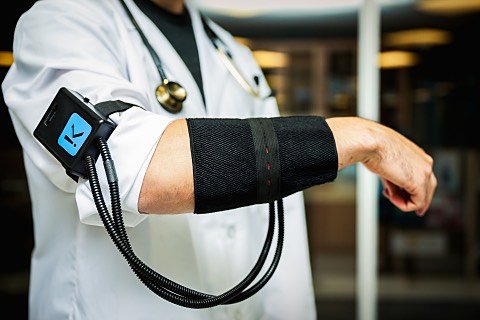SymPulse Relays Parkinson’s Tremors to Fire Doctors Up About Treatment

Klick Labs has developed a device that records and transmits Parkinson’s Disease tremors so doctors get a sense of what a patient goes through in real time.
By showing what a patient experiences, the hope is that the SymPulse Tele-Empathy Device prompts doctors to pay even more attention to patients’ needs, Klick Labs said.
The way the company puts it is that the device is designed to enhance clinical empathy in doctors, caregivers, family members and others who interact with people with movement disorders.
Digital-based Klick Labs is a division of Klick Health, a company that facilitates life-science technology. The labs operation is developing what it calls empathy-inducing technologies not only for Parkinson’s, but a number of other diseases as well.
This effort reflects a growing movement to develop more empathy in doctors and other medical practitioners. The philosophy behind the movement is that the greater the empathy, the better a patient’s care is likely to be.
Sympulse records and transmits patients’ tremor sensations wirelessly. That makes it different from other companies’ approach of using mechanical vibrations to replicate tremors.
Klick Labs’ device records a continuous feed of a patient’s electromyogram data. It is transmitted in real time via a Bluetooth wireless interface to an electrical muscle stimulation armband that a doctor or caregiver wears.
The armband triggers involuntary muscle activity that mimics the tremors the patient is experiencing. This helps physicians, caregivers and others understand the difficulties Parkinson’s patients face in trying to perform such simple tasks as using a cellphone or even buttoning clothing.
 “SymPulse is unique inasmuch as it improves empathy immediately by enabling the user to literally and accurately experience a patient’s symptoms,” Klick Labs Vice President Yan Fossat said in a company blog. “This is different from a mere immersive experience; this is true symptom transference.”
“SymPulse is unique inasmuch as it improves empathy immediately by enabling the user to literally and accurately experience a patient’s symptoms,” Klick Labs Vice President Yan Fossat said in a company blog. “This is different from a mere immersive experience; this is true symptom transference.”
“We are extremely encouraged about our work in technology-mediated symptom transference, which we call tele-empathy, to help make healthcare more patient-centric,” Fossat said in a press release.
Dr. Jodi Halpern, a professor of bioethics and medical humanities at the University of California at Berkeley, said “the skillful use of clinical empathy is essential for all three major aspects of effective medical care: accurate diagnosis, treatment adherence, and patient activation.”
“We need innovative approaches to inculcate empathy in physicians, including exciting new interactive technologies that enable people to experience other people’s symptoms,” added Halpern, author of the Oxford University Press book “From Detached Concern to Empathy: Humanizing Medical Practice.”
“Improving clinical empathy should be at the forefront” of efforts to achieve critical healthcare goals, said Dr. Helen Riess, an associate professor of psychiatry at Harvard Medical School and founder of Empathetics, Inc.
Riess was lead investigator of a randomized, controlled trial whose key finding was that 53 percent of physicians, by their own admission, had less empathy toward patients than they used to. Only 33 percent of respondents in the study reported more empathy.
The research, “Empathy Training for Resident Physicians: A Randomized Controlled Trial of a Neuroscience-Informed Curriculum,” was published in the Journal of General Internal Medicine.
“A brief intervention grounded in the neurobiology of empathy significantly improved physician empathy as rated by patients, suggesting that the quality of care in medicine could be improved by integrating the neuroscience of empathy into medical education,” the researchers concluded.
As part of the SymPulse rollout, Klick posted a video of Jim Smerdon, a 43-year-old early-onset Parkinson’s patient, using the device to transmit his tremors to his wife and twin brother Pat.
“It’s the first time I’ve ever seen my tremors in someone else,” Smerdon said. “I want everyone to be able to feel that.” If doctors and nurses could experience his tremors, he said, it could be “a real game changer for them.” The video is at https://klick.com/sympulse.
Fossat said future versions of SymPulse will be able to transmit symptoms over the Internet, which means they could be used for telemedicine. “We envision patients being able to transmit their tremors to physicians anywhere in the world to get more accurate diagnoses and better treatment,” he said.
This could help a lot of people, because an estimated 10 million people worldwide have Parkinson’s, according to the Parkinson’s Disease Foundation.
Klick Labs is also exploring symptom transfer in patients with diabetes and chronic obstructive pulmonary disease (COPD).
A lot of computer scientists and engineers are trying to create virtual reality (VR) experiences for the healthcare industry, Fossat said. Klick Labs believes the experiences should include health-practitioner empathy.
“We can leverage VR to bypass proprioception and simulate a particular gait of a patient with diabetic neuropathy or multiple sclerosis, and virtually put other people in that patient’s shoes,” he added.
For more information on the SymPulse Tele-Empathy Device and Klick Labs’ expertise in tele-empathy, visit:
https://www.klick.com/sympulse







